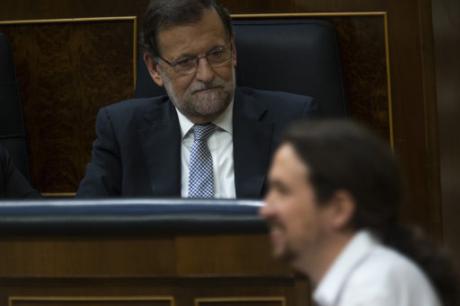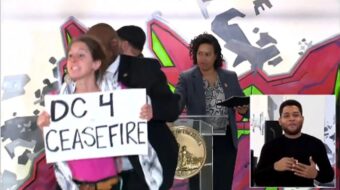
On June 26, Spanish voters went to the polls again to solve the deadlock that had come out of the December 20 2015 elections. In December, no party has gained enough seats in the lower house of the Spanish Parliament, the Cortes, to either form a government alone or as part of a coherent coalition. This time around, the results were a disappointment for the left, and forming a government may be just as difficult as before.
The Spanish election panorama is complicated, and various kinds of suspicions and animosities may have complicated the picture. The right is uniformly opposed to the national aspirations of Catalans, Basques, Galicians, Valencians, Canarians and other minorities, but the left-center is not united in favor of these aspirations. The elections reflect this messiness.
Election redux
In December 2015, the right wing People’s Party of Prime Minister Mariano Rajoy got the largest number of votes and parliamentary seats, but not nearly enough to even approach a parliamentary majority. So he went shopping for either a right wing coalition with the new Ciudadanos (Citizens’) Party, or a right-center coalition with the Socialist Workers’ Party (PSOE), Spain’s main social democratic group. Both turned Rajoy down, demanding that as a condition for working with the People’s Party, Rajoy, who is seen by many as especially corrupt, would have to step down as party leader and prime minister. So Rajoy had to report to the head of state, King Felipe VI, that he had not been able to form a government.
Next, the Socialist Workers’ Party gave it a try, but also failed: The left wing PODEMOS Party, which came in third in the polls, wanted its secretary general, Pablo Iglesias, to be named vice Prime Minister, and did not want to jettison its alliance with left wing separatist parties in Catalonia and the Basque country. This was anathema for PSOE, who proposed a three way coalition of PSOE, Podemos and Ciudadanos, based on the limited goal of ousting Rajoy as Prime Minister. But PODEMOS refused, pointing out that Ciudadanos is just as right wing as the People’s Party (with or without Rajoy) on important issues, including labor rights and austerity. So Rajoy remained as interim prime minister and June 26 was chosen as the date for a new election.
Podemos then attended to building new electoral alliances with other left wing parties. Most importantly, PODEMOS formed a coalition with the United Left (Izquierda Unida or IU) which itself is a united front structure involving the Spanish Communist Party and smaller left wing groups. The new group, Unidos Podemos (“United We Can”) stressed opposition to the neo-liberal program of austerity and privatization that had characterized Rajoy’s administration, while all parties denounced the very high level of corruption in the People’s Party.
The People’s Party and Ciudadanos responded with red baiting and scare tactics. In particular, the Spanish right tried to portray PODEMOS in general and Iglesias in particular as puppets of the late Venezuelan President Hugo Chavez, and also stoked fears of communism going back to the days of the Franco dictatorship. In fact, an NGO associated with Iglesias had done consulting work for the Bolivarian government of Venezuela, and this was made out to be something sinister in a country whose leaders have been heavily involved in trying to destabilize Venezuela.
But in spite of this 21st century McCarthyism versus 21st century socialism, polls showed Unidos Podemos as positioned to perhaps overtake the PSOE as the second party in Spain. This would have made possible a left-center coalition of PSOE, Podemos and United Left. It would have created a situation roughly similar to the one in Portugal, where the Socialist Party, led by Prime Minister Antonio Costa, was able to form a government with the outside support of the Communist, Green and United Left parliamentary delegations. Costa’s government quickly reversed some of the worst austerity measures that had been imposed by the previous right wing government, greatly angering the leadership of the European Union, but so far it retains strong mass support.
Iglesias also did well in campaign debates, and the scandals of the Rajoy administration did not let up for a minute. Not long before the election, a leaked phone conversation showed that Rajoy’s interior minister, Jorge Fernandez Diaz, had conspired with the anti-fraud czar of Catalonia, Daniel de Alfonso, to fabricate smears against Catalan Nationalist parties of left and right. Although this conversation took place in 2014, it fueled a widespread perception of Rajoy and his team as being dirty and unscrupulous. It appeared also that Rajoy himself was involved in this skulduggery.
But when election returns came in, the left had to face disappointment. On a lower turnout than in December, Rajoy’s People’s Party increased its vote totals by 4.3 percent and its representation in the lower house by 14 seats (from 123 to 137). It also solidified its majority in the upper house, the Senate.
The PSOE gained a few votes (up .7 percent) but lost five seats, going from 90 seats to 85.
Unidos Podemos lost more than a million votes compared to the total votes of its component parties in December (3.4 percent down) but kept its total of 71 seats. Ciudadanos was down .8 percent compared to December, but was the biggest loser in seats, saying goodbye to eight of the 40 seats it had won in December.
Results for smaller and regional parties showed the Catalan left (Esquerra Republicana Catalana or ERC) keeping all 9 of its seats but losing a few popular votes. The Catalan nationalist right, the Democratic Convergence, or CDC, kept its 8 seats, but also lost some popular votes. In the Basque country, the left wing Basque nationalist party, Bildu, kept its two seats, but the more conservative Basque party, the PNV, lost one seat. The Canarian Nationalist Coalition and allies held onto their single seat.
Whence unity?
Why did this disappointing result for the left occur? The lower turnout as compared with December 2015 appears to have worked mostly against the left. This is the view of Alberto Garzon, an important leader of both the United Left and the Communist Party, who pointed out in a letter to his party membership that the decline in voting since December almost exactly coincides with their loss of votes. Also, the red baiting might have had some impact. Some have wondered if the shock caused by the referendum vote on Brexit, British exit from the European Union, might have had some influence, although it should be noted that none of the major parties in Spain were running on a platform which included leaving the European Union. But the whole of the Spanish left has been critical of the European Union’s role in imposing neo-liberal austerity and privatization schemes on the poorer member countries, of which Spain is one. A general sense of uncertainty and worry caused by Brexit may have induced some voters to make less daring choices at the polls.
What happens now? It may be that a majority coalition can still not be formed. Rajoy will likely call on PSOE and Ciudadanos for coalition talks, but those two parties both say that a condition would be, at minimum, that Rajoy resign or be tossed overboard by the People’s Party. This Rajoy is refusing to do. Thus, the saga continues.
Photo: Spain’s acting Prime Minister Mariano Rajoy looks on as Podemos Party leader Pablo Iglesias walks past during the second of a two-day investiture debate at the Spanish parliament in Madrid, Wednesday, March 2, 2016. | Francisco Seco/AP












Comments